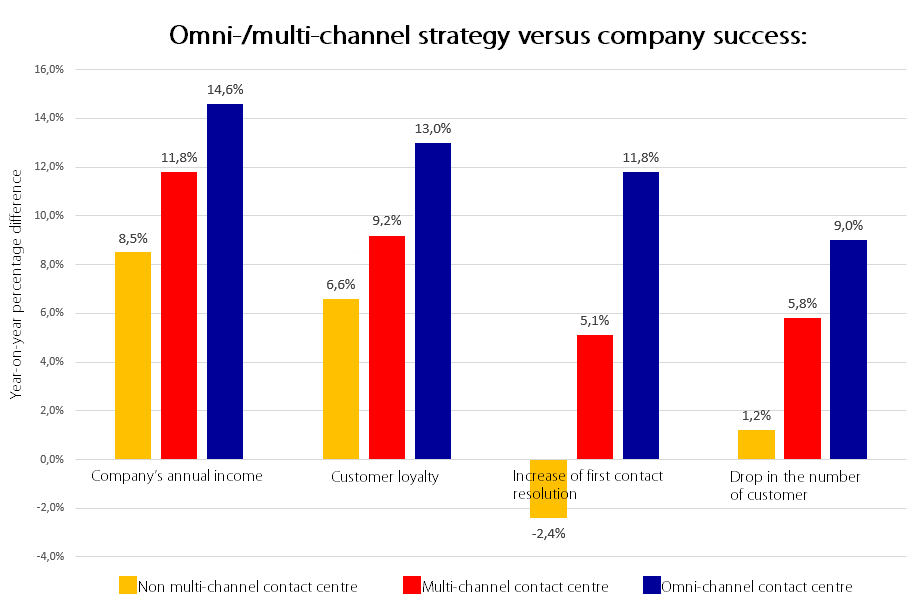
Omni-channel retailing, i.e. enabling customers to communicate with a company via different channels and allowing smooth transfer between them, is the next stage, after multi-channel communication, of developing customer service. Is your company already prepared for the omni-channel approach?
According to a report by Idealo (2014), the range of communication channels offered to European consumers is growing constantly. In addition to standard e-mail, contact forms and helplines, retailers use FAQ (frequently asked questions), chats, video chats and forums more and more frequently. An increasing number of customers are turning to communication through the social media and via SMS (a report by Aberdeen Group 2014).
The multi-channel approach, i.e. mere providing a few communication channels, is not enough to satisfy customers today. Customers expect seamless switching between communication channels, between offline and online contacts, immediate response of consultants and their full knowledge about the customer’s previous contacts with a company. They expect that all employees they have maintained contacts with will have the same information about the customer’s requirements, irrespective of the communication channel or time in which such information has been provided to the company. In other words, they expect the omni-channel approach. And such expectations are not to be ignored because, according to research, customer dissatisfaction with the quality of communication with a company translates directly into a lower value of orders made by shoppers (Forrester Research 2013).
Omni-/multi-channel strategy versus company success:
Aberdeen Group report 2014. Study carried out in November 2014 on a sample of 396 companies from the United States.
What should the omni-channel communication be like?
The most common mistake made in implementing the omni-channel communication is to assume that everything can be fixed by only providing a few communication channels, without redefining the company’s communication structure, making online and offline integration, and proper training of consultants.
Based on numerous market surveys conducted in the recent years, we will try to present the main expectations of customers and suggested omni-channel solutions.
1) online and offline integration – prices, discounts, range of goods, ordering possibility
No more discriminating between the Internet shoppers and ‘real-life’ shoppers. Introducing the standard of showrooming – watching products in-store before an online purchase, as well as webrooming – watching them online before a ‘real-life’ purchase. Different online and offline offerings only annoy consumers, who feel that the retailer tries to outwit them and hopes that customers will not check all the possibilities. Responsiveness or adjusting to mobile and desktop versions of retailers’ websites is a necessity (a report by Unity Commerce 2014).
2) factual integration of communication in a company
This is about immediate registration of each contact with a customer and of information provided by him/her in a central customer database (e.g. Focus miniCRM). The data is available to all company employees who maintain contacts with customers. Thus, telephone information according to which a customer has four children with whom he/she likes to spend time may be used during the next contact, e.g. on a chat.
The integration must also cover any information that leaves the company. Any offers presented to a customer by one consultant in one channel must be known immediately by all other consultants who are likely to contact that customer.
3) planned and organised communication
Follow-up communication should be planned after each customer contact (Focus Contact Center summaries – classifiers are a useful tool in that respect). This can be the sending of a holiday offer, information about an equipment repair progress, etc.
4) smooth communication
A typical problem – a website contains a contact form and a chat channel, indicates the telephone number and invites contacts via FB but… it provides no quick answer and it is hard to get through by phone. Customer e-mails should be answered not later than within 6 business hours. If a customer did not succeed in getting through, his/her call must be returned within one hour at the maximum (which can still be too late depending on the sector).
5) personalised communication
So, on the one hand, by having access to information on the previous contacts, employees refer in conversations and in correspondence to the specific needs and expectations of a given customer. And on the other they present themselves in a most personalised manner – the customer knows the names and surnames of the consultants, can see their photos during chat conversations or in the social media.
6) competent consultants
Enquiries and reports sent by any channel should be automatically referred to suitable individuals thanks to the use of connection routing mechanisms. In case of the multi- and omni-channel communication, the routing strategies must take into consideration consultants’ competencies regarding communication within a given channel. If skills-based routing (where agents’ understanding of a given product is the criterion) has been a long-time standard in most large contact centres, the use of so-called “context-based routing” becomes increasingly popular at the moment (Aberdeen Group 2014).
Context-based routing uses not only the consultants’ product-related knowledge, but also communication skills in a given channel (e.g. whether a consultant is comfortable with handling a chat conversation) as well as the previous relations with a given customer – e.g. which consultant has contacted that customer most frequently (a so-called relationship maintenance mechanism of Focus Contact Center).
Referring the customer to another channel is an awful situation, which unfortunately still occurs at many Polish companies. This happens when, for example, a consultant receives an enquiry during a chat and then asks the customer to dial a given telephone number.
Answering the main question above, yes – one may say that the omni-channel approach is a must already. Although still not used to the full in great many Polish companies, it is a hallmark of those “doomed to succeed”. Those who keep trying to be abreast of others and are not afraid of innovation.






